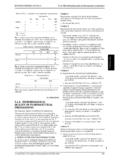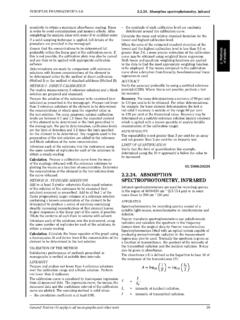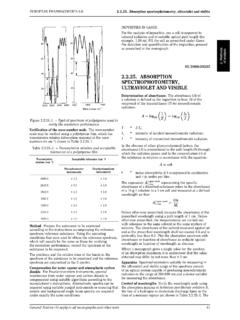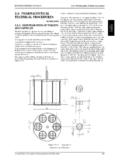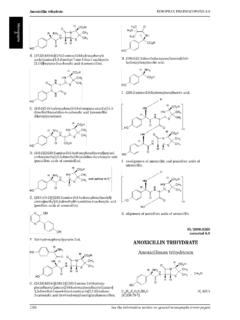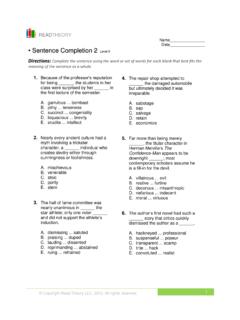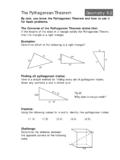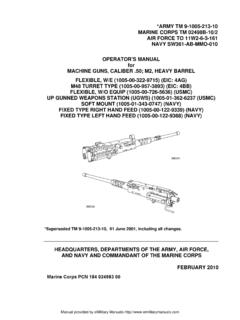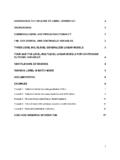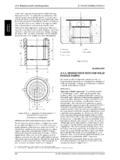Transcription of 2.9.36. POWDER FLOW - uspbpep.com
1 POWDER flow EUROPEAN PHARMACOPOEIA since the lattice parameters are comparatively large, the results. It bears repeating that no simple POWDER flow method symmetry is low and the scattering properties are normally will adequately or completely characterise the wide range of very low. For any given crystalline form of a substance, flow properties experienced in the pharmaceutical industry. knowledge of the crystal structure allows the calculation An appropriate strategy may well be the use of multiple of the corresponding XRPD pattern, thereby providing a standardised test methods to characterise the various aspects preferred-orientation-free' reference XRPD pattern, which of POWDER flow as needed by the pharmaceutical scientist. can then be used for batch comparisons. Refinement of crystal structures. Refinement of crystal structures consists of minimising the difference between ANGLE OF REPOSE. the intensities of the experimental diffraction pattern of a The angle of repose has been used in several branches of crystalline substance and the intensities calculated from a science to characterise the flow properties of solids.
2 Angle structural model sufficiently close to the true structure. The of repose is a characteristic related to interparticulate minimisation is carried out using a least squares method friction, or resistance to movement between particles. Angle (or other procedure) to refine the structural parameters of repose test results are reported to be very dependent of the model (unit cell dimensions, atom co-ordinates, site upon the method used. Experimental difficulties arise due occupancies) and the atomic displacement parameters, to segregation of material and consolidation or aeration of until a satisfactory agreement between calculated and the POWDER as the cone is formed. Despite its difficulties, the observed intensities is obtained. This application requires method continues to be used in the pharmaceutical industry, accurate diffraction data (intensity and position), containing and a number of examples demonstrating its value in sufficient information to estimate the structural parameters predicting manufacturing problems appear in the literature.
3 Concerned. Structure refinement is most often carried out by Rietveld-type methods, but the integrated intensity method The angle of repose is the constant, three-dimensional angle can also be applied. (relative to the horizontal base) assumed by a cone-like pile of material formed by any of several different methods, described briefly below. Basic methods for angle of repose A variety of angle of repose test methods are described in the 01/2008:20936 literature. The most common methods for determining the static angle of repose can be classified based on 2 important experimental variables : POWDER FLOW. the height of the funnel' through which the POWDER The widespread use of powders in the pharmaceutical passes may be fixed relative to the base, or the height may industry has generated a variety of methods for characterising be varied as the pile forms ;. POWDER flow. Not surprisingly, scores of references appear in the pharmaceutical literature, attempting to correlate the base upon which the pile forms may be of fixed the various measures of POWDER flow to manufacturing diameter or the diameter of the POWDER cone may be properties.
4 The development of such a variety of test allowed to vary as the pile forms. methods was inevitable ; POWDER behavior is multifaceted Variations in angle of repose methods and thus complicates the effort to characterise POWDER flow. Variations of the above methods have also been used to some The purpose of this chapter is to review the methods extent in the pharmaceutical literature : for characterising POWDER flow that have appeared most frequently in the pharmaceutical literature. In drained angle of repose : this is determined by allowing addition, while it is clear that no single and simple test an excess quantity of material positioned above a fixed method can adequately characterise the flow properties diameter base to "drain" from the container. Formation of pharmaceutical powders, this chapter proposes the of a cone of POWDER on the fixed diameter base allows standardisation of test methods that may be valuable during determination of the drained angle of repose ;. pharmaceutical development.
5 Dynamic angle of repose : this is determined by filling a 4 commonly reported methods for testing POWDER flow are : cylinder (with a clear, flat cover on one end) and rotating angle of repose, it at a specified speed. The dynamic angle of repose is the angle (relative to the horizontal) formed by the flowing compressibility index or Hausner ratio, POWDER . The internal angle of kinetic friction is defined by flow rate through an orifice, the plane separating those particles sliding down the top layer of the POWDER and those particles that are rotating shear cell. with the drum (with roughened surface). In addition, numerous variations of each of these basic General scale of flowability for angle of repose methods are available. Given the number of test methods and variations, standardising the test methodology, where While there is some variation in the qualitative description possible, would be advantageous. of POWDER flow using the angle of repose, much of the pharmaceutical literature appears to be consistent with the With this goal in mind, the most frequently used methods classification by Carr(1), which is shown in Table are discussed below.
6 Important experimental considerations There are examples in the literature of formulations with are identified and recommendations are made regarding an angle of repose in the range of 40-50 degrees that standardisation of the methods. In general, any method manufactured satisfactorily. When the angle of repose of measuring POWDER flow must be practical, useful, exceeds 50 degrees, the flow is rarely acceptable for reproducible and sensitive, and must yield meaningful manufacturing purposes. 320 See the information section on general monographs (cover pages). EUROPEAN PHARMACOPOEIA POWDER flow Table Flow properties and corresponding compressibility index and the Hausner ratio are calculated angles of repose(1) as follows : Flow property Angle of repose (degrees). Excellent 25-30. Good 31-35. Fair (aid not needed) 36-40. Passable (may hang up) 41-45 Alternatively, the compressibility index and Hausner ratio 46-55. may be calculated using measured values of bulk density Poor (must agitate, vibrate).
7 ( bulk) and tapped density ( tapped) as follows : Very poor 56-65. Very, very poor > 66. (1) Carr RL. Evaluating flow properties of solids. Chem. Eng 1965 ;. 72:163-168. Experimental considerations for angle of repose Angle of repose is not an intrinsic property of the POWDER , In a variation of these methods, the rate of consolidation that is to say, it is very much dependent upon the method is sometimes measured rather than, or in addition to, used to form the cone of POWDER . On this subject, the the change in volume that occurs on tapping. For the existing literature raises these important considerations : compressibility index and the Hausner ratio, the generally the peak of the cone of POWDER can be distorted by the accepted scale of flowability is given in Table impact of POWDER from above. By carefully building the Table Scale of flowability(1). POWDER cone, the distortion caused by impact can be minimised ; Compressibility Flow character Hausner ratio index (per cent).
8 The nature of the base upon which the POWDER cone is 1-10 Excellent formed influences the angle of repose. It is recommended that the POWDER cone be formed on a common base', 11-15 Good which can be achieved by forming the cone of POWDER on 16-20 Fair a layer of POWDER . This can be done by using a base of fixed diameter with a protruding outer edge to retain a 21-25 Passable layer of POWDER upon which the cone is formed. 26-31 Poor Recommended procedure for angle of repose 32-37 Very poor Form the angle of repose on a fixed base with a retaining lip > 38 Very, very poor > to retain a layer of POWDER on the base. The base must be free of vibration. Vary the height of the funnel to carefully (1) Carr RL. Evaluating flow properties of solids. Chem Eng 1965 ;. 72:163-168. build up a symmetrical cone of POWDER . Care must be taken to prevent vibration as the funnel is moved. The Experimental considerations for the compressibility index funnel height is maintained at approximately 2-4 cm from and Hausner ratio the top of the POWDER pile as it is being formed in order to Compressibility index and Hausner ratio are not intrinsic minimise the impact of falling POWDER on the tip of the cone.
9 Properties of the POWDER , that is to say, they are dependent If a symmetrical cone of POWDER cannot be successfully upon the methodology used. The existing literature or reproducibly prepared, this method is not appropriate. points out several important considerations affecting the Determine the angle of repose by measuring the height of determination of the unsettled apparent volume, V0, of the the cone of POWDER and calculating the angle of repose, , final tapped volume, Vf, of the bulk density, bulk, and of the from the following equation : tapped density, tapped : the diameter of the cylinder used, the number of times the POWDER is tapped to achieve the tapped density, COMPRESSIBILITY INDEX AND HAUSNER RATIO the mass of material used in the test, In recent years the compressibility index and the closely rotation of the sample during tapping. related Hausner ratio have become the simple, fast, and Recommended procedure for compressibility index and popular methods of predicting POWDER flow characteristics.
10 Hausner ratio The compressibility index has been proposed as an indirect measure of bulk density, size and shape, surface area, Use a 250 ml volumetric cylinder with a test sample mass moisture content, and cohesiveness of materials, because of 100 g. Smaller amounts and volumes may be used, but all of these can influence the observed compressibility variations in the method must be described with the results. index. The compressibility index and the Hausner ratio are An average of 3 determinations is recommended. determined by measuring both the bulk volume and tapped FLOW THROUGH AN ORIFICE. volume of a POWDER . The flow rate of a material depends upon many factors, some Basic methods for compressibility index and Hausner ratio of which are particle-related and some related to the process. While there are some variations in the method of determining Monitoring the rate of flow of material through an orifice the compressibility index and Hausner ratio, the basic has been proposed as a better measure of POWDER flowability.
